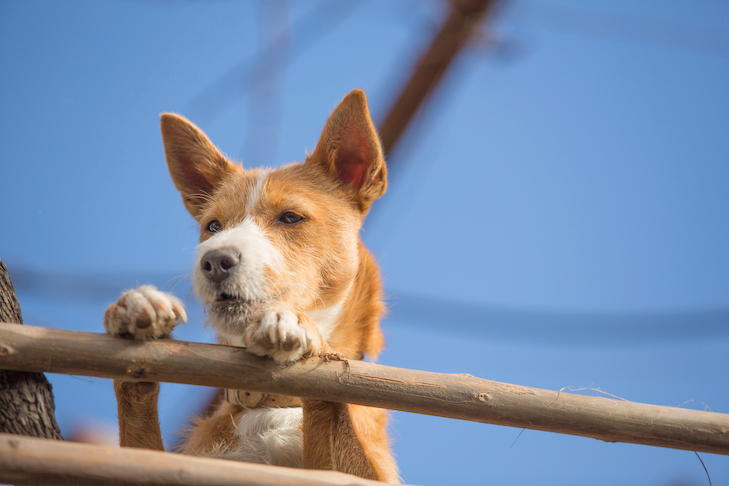In the words of Robert Frost, “Good fences make good neighbors.” But when it comes to dogs and backyards, fences are essential items to keep your pet safe and secure. Fences create safe outdoor spaces for your dog to run, play, sniff, and snooze — all without a leash. Plus, an enclosed yard with a secure gate gives owners peace of mind that diggers, climbers, and jumpers won’t escape. But what type of dog fence is best for your home and your pet?
What Dog Fence Is Right for Your Dog?
If you need to enclose your backyard but wonder what type of canine-friendly barrier will offer the best look, privacy, and safety, you can start by considering how your dog spends time in the yard. Your dog’s habits and activity level will help you choose the right fence.
Does your dog like to sunbathe all the time, rather than chasing critters or barking at neighbors? If your dog is mostly relaxed and just enjoys lounging when outdoors, you may not need a particularly high or strong fence. The same goes if your dog loves sniffing every square inch of space but doesn’t pursue those smells or chase after them.

Alternatively, if your dog is fascinated by wildlife and runs after any squirrels, birds, or rabbits that they see, fence height and strength matter. You don’t want your dog to jump a low fence (or burst through or burrow under) a weak fence while trying to catch their prey.
If your dog is particularly protective and stands guard when they’re out in the yard, you’ll need to make sure your fence has a particularly strong gate. If your dog spots someone they believe could be an intruder, they might try to get to that person, no matter what’s in their way. To ensure your dog won’t be able to jump over or burrow under the fence, you’ll need a high fence with bottom barriers. Does your dog love to dig? You’ll need to include bottom barriers. Similarly, if you have a dog who wants to escape, you’ll definitely need a solid fence that they can’t burrow under, jump over, or bust through.
In addition to secure fencing, high-energy or lonely dogs may need additional enrichment or time with you to stay engaged. Consider playing cognitive training games with your dog or putting some treats in a puzzle toy.
What Dog Fence Is Right for You?
You’ll need to consider your budget, especially when it comes to the size of your yard. In order to create a safe dog fence, will you be able to afford enough of the materials you want? The cost of all types of fences will vary, according to geography, size, and installation.
You’ll also want to consider the weather, durability, and maintenance. For example, if you live in an area with high rainfall or sunlight, wooden fences might not be the best choice because wood can rot, warp, or fade.
Some housing associations have fencing restrictions and requirements that may affect your choices. For communities prohibiting fencing, consider putting up an enclosed dog run or exercise pen near the house. These options will give your dog room to safely roam off-leash.
If you already have fencing that your dog has jumped, climbed, or dug, consider modifying the barrier by adding additional structures at the top or bottom. Figure out how your dog is getting over or beyond the fence and remove or cover up anything helping them get past it (such as gaping holes, lawn furniture, a stack of firewood, or a storage unit). To create a dig-proof barrier under any fence, install strips of metal, cement, or large rocks one to two feet below the surface of the fence line.
Types of Dog Fences
Here are some of the most common types of dog fences, as well as the possible pros and cons of each.
Chain Link Fence
If you’re looking to fence in a large area, consider metal or chain link, which is extremely popular. This option is low-cost, durable, weather-resistant, low-maintenance, and long-lasting.
Chain link fencing doesn’t offer any additional privacy (unless you decide to add barriers, such as tall landscaping, in front of the fence). If a piece of the chain link fence breaks, it could cut your dog. You will also need to add bottom barriers to prevent your dog from digging out. Jumpers and climbers may even use the links in the fence to scale up and over.

Vinyl Panel Fence
Vinyl panel fencing is durable, meaning it won’t fade, rot, weaken, decay, or chip. Plus, it’s scratch-resistant and easy to maintain — there’s no painting or sealing required. You can maintain its appearance with a yearly power wash. Vinyl panel fencing provides privacy, blocking anyone from looking in. It provides no gaps for dogs to squeeze through, and its smooth surface is difficult to climb.
Vinyl panel fencing is more expensive than metal fencing. Also, unless you put plants or trees against the fence’s surface, bright white panels will reflect the sun, creating a glare. When under extreme conditions (like a high-temperature fire), vinyl paneling may release chemicals like the carcinogen dioxin, but this material doesn’t pose significant environmental or human risks once it’s installed and used properly.
Wooden Fence
Wood can be relatively affordable as a material to build backyard fences. You can also customize your fence by choosing different woods, such as cedar, pine, spruce, fir, or redwood, in different shapes, shades, and textures. To further customize your fence’s appearance, you can paint or stain it, adding horizontal or vertical slats. Naturally biodegradable, wood can provide privacy (as long as there isn’t room between the slats). Wood also is an effective sound barrier.
Wood fences aren’t a one-size-fits-all solution, though. This material might not be as long-lasting as you’d like (in some cases, it might only last five years). To prevent fading from sunlight or rotting from rain or water damage, wood requires yearly painting or sealing. Wet weather can also warp wood, which might mean frequent repair.
If you decide to incorporate open horizontal slats, those might give dogs a ladder to climb over. Also, any loose boards or nails can injure your pet.
Picket Fence
If you choose a picket fence for your dog, you may face some of the same benefits and challenges as those building other types of wooden fences. Picket fencing is relatively affordable and short in height (so it doesn’t block your view). Visually attractive, a picket fence may be a good fit for small or calm dogs with no interest in jumping or climbing.
On the other hand, because picket fencing is short, it might not provide enough privacy. Dogs can also squeeze through any large gaps between slats, and picket fences aren’t tall enough to contain large dogs or those particularly determined to get up and over.

Wrought-Iron Fence
A wrought-iron fence offers a sleek, open appearance without blocking your view. The material is durable and won’t warp. However, using wrought iron can be expensive. Dogs with high prey drives will be able to see through the bars and might get distracted, while small dogs can wiggle out between the bars and escape. In addition, you may need to repaint the fence to maintain its shiny appearance.
Block, Brick, and Stone Fences
These durable materials are strong and sturdy, offering a pleasing appearance and numerous decorative options. Cement footing prevents dogs from burrowing under and escaping. These fences also don’t require much maintenance other than checking for chipped cement filler.
Block, brick, and stone fences may be quite expensive to install. Partially for that reason, these fences are often shorter, meaning would-be canine escape artists or large dogs might be able to jump over them.
Block Bottom and Wrought-Iron Top Fences
These combination fences offer a mixture of stability, durability, and visibility. They have a pleasing appearance and include multiple decorative options. Using blocks at the bottom will prevent digging dogs from escaping, while dogs shouldn’t be able to escape through a wrought-iron top that’s tall enough.
This option may be expensive to install. In addition, to maintain its appearance, you may have to paint the wrought iron surface regularly.








